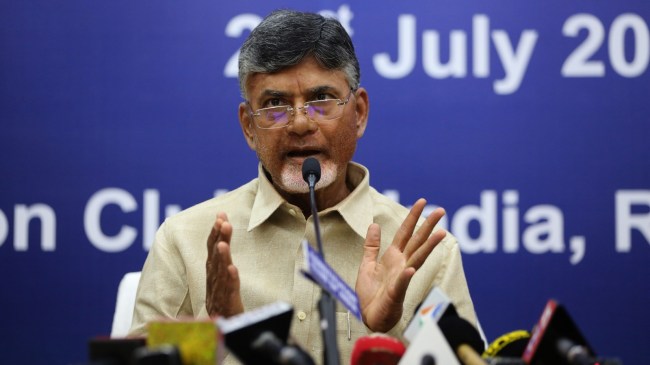Opinion Caste, dynasty and state capital: Three factors that have shaped Andhra Pradesh politics
With the spread of Western education during the colonial period, the educated Brahmin community took the lead in creating awareness about the importance of nationalism and the Telugu regional identity
 The TDP, as a ruling party from 2014 to 2019 and 2024 onwards, has been concentrating on building a highly centralised capital at Amaravati.
The TDP, as a ruling party from 2014 to 2019 and 2024 onwards, has been concentrating on building a highly centralised capital at Amaravati. In Andhra Pradesh, three factors have shaped the contours of contemporary politics: the Capitalist economy, dynastic politics and the question of the state capital. These factors influenced the dominant castes’ role in politics and the formation of political parties. Broadly, there are three phases in the political process of Andhra Pradesh: One, the consolidation of the Telugu identity from the early 20th century, resulting in separation from the Madras state in 1953; two, the phase of dominant caste politics from the 1950s right until the bifurcation of the composite state into Telangana and residual AP in 2014; three, the rise of dynastic politics from 2014. In the last phase, political power in the state has been in the hands of three families.
The growing phenomenon of dynastic politics needs to be explained in the historical context of the political economy. The building of irrigation infrastructure from the late 19th century onwards by the colonial rulers in coastal Andhra, like the Dhavaleswaram project across the Godavari, and the Nagarjuna Sagar and Srisailam dams across the Krishna after Independence, turned drought-prone areas into rice bowls. Subsequently, the Green Revolution contributed immensely towards the rise of rich capitalist farmers from dominant castes such as Kamma, Kapu, Rajus and Reddys.
With the spread of Western education during the colonial period, the educated Brahmin community took the lead in creating awareness about the importance of nationalism and the Telugu regional identity. The Andhra Mahasabha came into existence in 1930 to advocate for the rights of the Telugus in the Madras state. In 1937, the Sri Bagh pact was signed with the feudal lords of Rayalaseema, which was more backward compared to the prosperous coastal region. Over time, the linguistic movement intensified, and the prominent Gandhian Potti Sriramulu went on a fast unto death to carve Andhra out from the multilingual Madras state.
Andhra State was created in 1953, and the Reddy community prevailed upon Jawaharlal Nehru to make Kurnool in Rayalaseema the state capital. However, the move was opposed by N G Ranga, a veteran freedom fighter-cum-Congress leader from the Kamma caste of Guntur district. He demanded that Vijayawada be made the capital of Andhra. By 1956, political conditions favoured the creation of Vishalandhra by merging the Telugu-speaking parts of Hyderabad State (Telangana) through the Gentleman’s Agreement.
Initially, the electoral fray saw a Congress vs Communists contest, both controlled by the Reddys and Kammas. In fact, from 1956-1983 until the emergence of the Telugu Desam Party (TDP), Congress was in power. After matinee idol NT Rama Rao floated the TDP, Congress was defeated for the first time in composite AP, and from the 1980s onwards, the state swung between Congress and TDP. From 1956 to 2014, Reddys, who formed 6.5 per cent of the population, held 27 per cent of the political representation and the Kammas, who were 4.5 per cent of the population, held 13 per cent of the political representation. For more than 30 years, the chief minister’s position was captured by the Reddys and more than 20 years by Kammas and the rest of the period by the Brahmins, Vaishyas, Velamas and a Dalit.
As a result of the dominant and upper-caste rule of more than five decades, the regional fragmentation was aggravated by the bifurcation of the state, while class and caste politics were suppressed. Elections became costly affairs, with a social deficit of representation created due to the disproportionate representation of the landed dominant castes in political power and the conversion of Hyderabad into a centre of global capital at the cost of opportunities for the local population.
With the bifurcation of AP, the TDP and Yuvajana Sramika Rythu Congress Party (YSRCP) have emerged as the contenders for political domination in the residual state, with both dominated, in turn, by the dynasty. In 1995, TDP was captured by NTR’s son-in-law Chandrababu Naidu, who has been the party president for the last three decades and is now promoting his son Lokesh as the future of the party. YS Jagan Mohan Reddy (Jagan) is the son of the former chief minister YS Rajasekhara Reddy, who died in a helicopter accident in 2009. When the Congress party refused to make him the chief minister, he floated the YSRCP in 2011. The party contested in the 2014 election to encash YSR’s political legacy, but that only resulted in opposition status.
The TDP, as a ruling party from 2014 to 2019 and 2024 onwards, has been concentrating on building a highly centralised capital at Amaravati, which is located in the green belt of coastal Andhra, with 34,000 acres of land already acquired. When it was in power from 2019 to 2024, the YSRCP proposed three capitals at Amaravati, Visakhapatnam and Kurnool. However, Jagan’s proposal failed in the 2024 election, and Naidu’s plan to build a global city is back in full swing. Thanks to TDP joining the NDA coalition, Amaravati is getting support from the centre. Therefore, the entire exercise of global capital has been characterised by Carol Upadhya as the “reterritorialisation of the deterritorialised Kamma caste” in the form of building a world-class capital.
The writer teaches in the department of Political Science, University of Hyderabad





